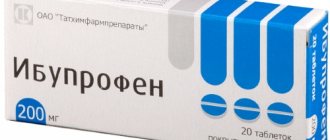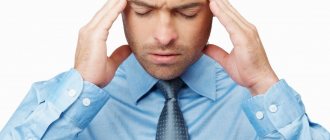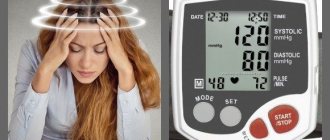Vegetative-vascular dystonia (VSD) is a disease in which the functioning of the autonomic nervous system is disrupted, causing many organs to cease to function normally. This pathology is accompanied by various symptoms. Drowsiness is often observed, the development of which is caused by disruptions in the functioning of the nervous system. Coping with this condition is difficult, but with the right approach to treatment it is possible.
What is VSD?
Vegetative-vascular dystonia is not a disease. This is a symptom complex that occurs for one reason or another.
Symptoms of a disorder of the autonomic nervous system can be different:
- panic;
- dyspnea;
- weakness;
- weather dependence;
Exacerbation of VSD may occur unexpectedly
- tinnitus;
- change of mood;
- problems with sleep and memory;
- hand trembling;
- chills;
- blood pressure fluctuations;
- dizziness and headache.
Both adults and children can experience these symptoms. According to medical statistics, women are more susceptible to the disease than men. Signs of VSD often appear during menstruation, and the reason for this is a hormonal imbalance. During menstruation, the secretion of the hormones estrogen and progesterone is disrupted.
How to reduce the likelihood of exacerbation of the disease?
Acute dystonia is characterized by the following symptoms:
- Trembling in fingertips.
- Decreased sexual desire.
- Discomfort in the heart area.
- Increased breathing.
- Nausea.
- Impaired functions of the cardiovascular system.
- Painful sensations in the head area.
Acute dystonia forces the body to work under strain. The patient may experience convulsions, often experience unreasonable fear, and complain of tinnitus.
In order to reduce the symptoms that occur with VSD in the acute stage, conservative methods are often used. Many experts are of the opinion that potent drugs should be used only in extreme cases.
Conservative treatment allows you to stop an attack of the disease and improve the patient’s quality of life. The duration of the treatment course is determined individually. When prescribing medications, the doctor pays attention to the gender and age of the patient, and he also takes into account the characteristics of the course of the disease.
Some patients may doubt: does conservative treatment help with exacerbation of vegetative-vascular dystonia? The answer to this question lies on the surface:
- Specialized drugs help normalize blood pressure and improve cerebral circulation, which is disrupted with vegetative-vascular dystonia.
- Conservative treatment eliminates the feeling of heaviness in the head.
- When taking medications, pain in the head area disappears, and the functioning of the autonomic nervous system improves.
- Medications are excellent for relieving fatigue and irritability.
Vegetative crises
A vegetative crisis is a paroxysmal state characterized by the manifestation of anxiety with fear and various somatic signs. When does VSD worsen? The causes of VSD in medicine are still not fully understood.
But the following factors can serve as an impetus for the development of a crisis:
- endocrine diseases;
- disruption of the heart;
- genetic predisposition;
- taking certain medications;
- stress;
- hormonal disbalance.
Vegetative-vascular dystonia is a violation of vascular tone and autonomic dysfunction
The clinical picture depends on the severity of the crisis. To assess the severity of panic disorder, a special scale is used:
- Light form. In the clinical picture, one or two symptoms are observed. VSD exacerbation lasts 10-15 minutes. At the end of the crisis, asthenia is not observed.
- Medium shape. Several symptoms predominate in the clinic. The duration of the attack is 20 minutes or more. After the crisis is over, your health does not improve for some time.
- Severe form. It is extremely difficult. Convulsions and fainting are possible. Asthenia is observed for the next 2-3 days.
Upon completion of the crisis, a person develops a persistent expectation of the next attack. Against this background, he may develop depression. Often, after the first attack, the patient develops a phobia. He is afraid of those places and situations that preceded the exacerbation of symptoms.
What symptoms are accompanied by VSD and cervical osteochondrosis?
The abbreviation VSD hides regulatory disorders of vascular tone and cardiac activity.
And one of the manifestations of cervical osteochondrosis is vertebral artery syndrome, which occurs due to changes in the vascular course in the processes of the cervical vertebrae. And if osteochondrosis makes only two arteries involved in the pathological process, then vegetative-vascular dystonia affects all the vessels of the body that have a muscular wall.
The fundamental cause of VSD is considered to be physical or psycho-emotional overload, when a functional failure occurs in the body’s equilibrium control of two branches of the autonomic nervous system - sympathetic and parasympathetic.
How do VSD and cervical osteochondrosis depend on each other?
Despite the fact that the main clinical attention during VSD is paid to vascular tone, the symptoms of this syndrome are much more diverse.
Our readers successfully use SustaLife to treat joints. Seeing how popular this product is, we decided to bring it to your attention. Read more here...
This is due to the fact that each organ in one system or another is served by branches of both the sympathetic and parasympathetic departments, mutually balancing the action of each other.
So can osteochondrosis provoke vascular dystonia? It is obvious that two pathological processes run parallel to each other.
But regardless of which of the processes developed first, cervical osteochondrosis with VSD will necessarily complicate the course of vascular dystonia.
Difficulty of clinical differentiation of VSD from cervical osteochondrosis with vertebral artery syndrome
Clinical manifestations of cervical osteochondrosis with compression of the nerve roots always have a tinge of interest from the sympathetic nervous system.
The appearance of a vascular pattern in osteochondrosis on the affected side, changes in sweat secretion, skin temperature reaction and the detection of Horner's syndrome are all manifestations of focal irritation of the sympathetic chain.
But all the above symptoms have nothing to do with the clinical picture of vascular dystonia. Violation of the autonomic regulation of vascular tone is included in the sum of cardiac complaints and instability of blood pressure.
Symptoms of VSD and cervical osteochondrosis can combine two diseases. For example, dizziness, tinnitus, darkening of the eyes, nausea, and lightheadedness may be common to both pathologies. This commonality of individual symptoms of VSD and osteochondrosis of the cervical spine is due to impaired blood supply to the brain.
Dystonia syndrome in the context of the disease and methods for correcting impaired vascular tone
Vegetative-vascular dystonia is not a disease, but a syndrome. And more often, this syndrome accompanies the clinical picture of neurosis and is mainly detected at a fairly young age, until the moment when organic cardiovascular pathology is formed - hypertension, atherosclerosis, osteochondrosis. However, the combination of VSD with cervical osteochondrosis does occur.
Treatment of cervical osteochondrosis and VSD of the type of sympathoadrenal crisis is carried out by vascular therapy with the prescription of individual antihypertensive drugs.
With the vagoinsular variant of the course of VSD, the choice of therapy stops at the selection of psychotropic drugs, the work of a psychoanalyst, and general restorative procedures.
Dystonia of individual vertebral arteries can develop against the background of cervical osteochondrosis and be associated with irritation of the vascular wall by deformations of the canal of the vertebral arteries.
This condition is included in the manifestation of vertebral artery syndrome, but does not give any reason to classify it as VSD.
Dystonia is characterized by an uncontrolled alternation of spasm of the vascular wall with its paralytic relaxation. In both cases, oxygen starvation of the brain occurs with corresponding symptoms.
Causes of panic attacks
Often they try to link cervical osteochondrosis and VSD with panic attacks. There is some reasonable grain in this.
If we start with the fact that a panic attack is a sudden feeling of fear that is inadequate to the environment, accompanied by an increase in blood pressure and heart rate, then the connection between a panic attack and a sympathoadrenal crisis becomes obvious.
In this case, you can simply settle on the diagnosis of vegetative-vascular dystonia, occurring against the background of cervical osteochondrosis. But, the clinic of panic attacks may be accompanied by ganglioneuromas and pheochromocytoma. In addition, during panic attacks, mental phenomena such as depersonalization and derealization can be observed. And in this case, it becomes necessary to consult a psychiatrist to differentiate neurosis from more serious diseases.
You will learn more about the connection between panic attacks and osteochondrosis from the video:
Vegetative-vascular dystonia is the result of an imbalance of regulatory systems and can accompany cervical osteochondrosis, as a manifestation of one or another neurosis.
If panic attacks occur, do not be afraid of consulting specialists, including psychiatrists.
After all, the goal of turning to the medical community is to establish the correct diagnosis with the correct treatment, which will allow you to return to your usual lifestyle and optimal well-being.
Vagoinsular attacks
Vagoinsular attacks occur when there is a disruption in the functioning of the ANS. Such a crisis occurs due to a sharp release of insulin into the blood. This entails a number of violations. The level of glucose in the blood decreases, and the person’s well-being deteriorates sharply.
Manifestation of vagoinsular crisis:
- temperature increase;
- heat;
- nausea;
- sweating;
- weak pulse;
- skin redness;
- intestinal disorder;
- fainting.
Symptoms of VSD are quite diverse and affect many organs and systems of the body.
After the disappearance of the above symptoms, the person’s well-being does not improve for some time. Weakness, anxiety and shortness of breath may occur.
Vagoinsular attacks are diagnosed in both children and adolescents. The reasons are strong emotional experiences and fear. Symptoms are often dominated by headache and migraine.
With VSD muscle weakness
Weakness with VSD is one of the most common signs, occurring in 95% of cases. This is precisely the basis for doctors to consider it one of the most striking symptoms for diagnosing the disease. How does it manifest itself? Is it possible to overcome it? How is dystonia diagnosed?
Vegetovascular dystonia (abbreviated VSD) makes itself felt not only by debilitating weakness. With this syndrome, almost all organs are affected: the heart aches, the head is dizzy, the heart is pounding or slows down.
A person loses strength in a matter of hours, and with it the desire to think positively disappears, despondency sets in, which often leads people with dystonia syndrome to severe attacks of panic attacks, anxiety and even prolonged depression.
Are you seeing these signs in yourself? It's worth getting tested.
With VSD, general weakness of the body is felt, stomach pain, headache, heart aches
Signs of VSD
Most often, patients note disturbances in the functioning of the heart and coordination system, when everything around begins to spin and it becomes difficult to maintain balance. Some even faint from time to time.
What other symptoms may indicate dystonia:
- Arrhythmia.
- Drowsiness.
- Increased sweating.
- Tachycardia.
- Increased heart rate.
- Dizziness.
- Irritability.
- Sudden mood swings.
Many people ask: can VSD cause weakness in the arms and legs? It turns out yes.
It is in the limbs that the feeling of weakness is localized when they temporarily lose their functionality. It becomes difficult to raise your arms, they become leaden, and your legs turn into cotton. The first reaction of any person is a feeling of helplessness, a desire to lie down and give up on everything.
What can cause changes in well-being?
With VSD, weakness in the legs is pronounced
Causes of dystonia
One of the most important reasons for the appearance of the syndrome is considered to be heredity. Simply put, a person is already born with a predisposition to the disease and, as soon as unfavorable provoking factors arise, it quickly worsens.
When can the syndrome make itself felt?
- In case of hormonal imbalance during pregnancy, menopause.
- About the reason for the surge of hormones in adolescence.
- Against the backdrop of severe stress due to the loss of a loved one.
- In case of disruption of the endocrine system.
- If you are very tired due to mental stress, for example after exams.
It is important to know! Women are at risk: after all, they more often experience hormonal shocks and worry even about little things.
Also, VSD can “mow down” adolescents and people with excess body weight: excess weight is always an additional burden on a person, which means the cardiovascular system is overloaded.
The syndrome can make itself felt against the background of severe stress or excessive fatigue
How is diagnostics carried out?
Because dystonia is always a complex health problem, diagnosing it can be difficult.
And with all these unpleasant manifestations, vegetative-vascular dystonia (VSD) is not recognized by many doctors as a separate disease.
They consider this a syndrome that is accompanied by numerous unpleasant symptoms and affects several systems and organs of human life.
Sometimes doctors advise you to get enough sleep, take vitamins, hoping that your general condition will return to normal. Doctors often turn out to be fair, but it happens that VSD is delayed and then consultation with several specialists may be required: a therapist, a cardiologist, a neurologist, an endocrinologist, and even a psychotherapist.
For a correct diagnosis and subsequent effective fight against muscle weakness, for VSD it is better to undergo:
- Magnetic resonance imaging.
- Rheovasography (study of blood circulation in the upper and lower extremities of a person).
- Rheoencephalography (study of cerebral vessels).
- Echocardiography.
At the appointment, the doctor will definitely clarify whether there have been similar cases in the family, because, as already mentioned, very often the disease is hereditary.
Magnetic resonance imaging is the best way to diagnose the disease
Why does weakness occur?
How to explain the mechanism of muscle weakness during VSD? The reason lies in carbohydrate metabolism. It is no secret that carbohydrates are one of the main sources of energy that the body “draws” from nutrition. The supply of this valuable substance is constantly stored in the human liver and muscles in the form of glycogen and is consumed as needed.
To get energy from muscles, a person must move: biochemical processes are designed in such a way that glucose is released from glycogen only during physical activity, and in a passive position it practically does not arrive.
That is why doctors are sure that the feeling can be expelled by performing active, intense movements. Do you feel exhausted, exhausted by weakness in your legs due to VSD? Do five minutes of exercise. Are you tempted to give in to laziness? Stretch your arms in different directions, bend to the side, or simply dance to your favorite tune.
What is the secret of physical inactivity? Movement is the biggest “enemy” of dystonia. The whole point is that the contraction and relaxation of muscles that occurs during movement contributes to the production of energy, and life returns to the person: muscle tone returns, and helplessness leaves.
Rules for combating the disease
How to overcome severe weakness with VSD? The most important thing is to start moving. Physical activity (even the most moderate) will help get rid of it in a short time.
Psychosomatic symptoms of attacks
The ANS regulates the functioning of internal organs and systems. It acts as a link between the body and the psychological state of a person. Mental experiences have a negative impact on health. When exposed to external factors, the psyche reacts instantly and, based on what is happening, produces a reaction.
With VSD, psychosomatic symptoms manifest themselves as:
- rapid heartbeat and breathing;
- feelings of anxiety;
- panic attack;
- disorientation;
- causeless fear.
These symptoms cannot be left to chance. In the future, they can cause the development of phobias and neurological disorders.
Why does one want to sleep when stressed?
Psychologists and psychiatrists convince: any symptoms of VSD are just your body’s reaction to stress, and the stronger the stress, the stronger the symptoms. If you constantly want to sleep with VSD and neurosis, the reasons may lie in the following.
- Disturbance in the rhythm of sleep and wakefulness. The time of sleep and wakefulness is determined by special areas of our brain. But this complex system can be knocked out of order if a person is regularly exposed to stress, lack of sleep or overwork. Thus, a person sleeps poorly at night and feels drowsy during the day.
- Chronic fatigue. With neurosis, people are regularly under stress, because there are so many phobias, fears and panic attacks in their lives. And under stress, a person lives in a mode of increased mobilization, which requires significant energy expenditure. Thus, with prolonged stress, the body’s resources are exhausted, and chronic fatigue appears, in which you constantly want to sleep.
- If you take anti-anxiety medications, such as antidepressants, drowsiness may simply be a side effect of these medications.
How does the attack go?
Every crisis unfolds differently. The end of the sympathetic crisis is indicated by a decrease in blood pressure, excessive urination, loss of strength, and apathy. Weakness may continue for 2-3 days. A parasympathetic attack ends with profuse sweating, severe fatigue and weakness. Red spots may appear on the face.
Almost all patients experience cardiac syndrome, in which there are interruptions in heart rhythm, cardiac arrest, and possible chest pain
Asthenic syndrome with VSD
When the VNS malfunctions, asthenic syndrome may appear. There are two types of asthenia:
- Hypersthenic. This type is characterized by excessive activity, aggressiveness, irritability, and hypersensitivity.
- Hyposthenic. The dominant symptom is lethargy, fatigue, apathy, and insomnia.
A clear sign of asthenic syndrome is:
- weather dependence (sensitivity to weather changes);
- sudden change of mood;
- depletion of cognitive processes;
- headache and muscle pain;
- tremor.
Asthenic syndrome should not be confused with depression. The main difference is that with depression it is more difficult for a person to survive the morning hours, and with asthenia, on the contrary, it is more difficult to survive the evening hours. Asthenia is not preceded by mental and physical stress. Long rest, relaxation and general stimulants do not bring improvement.
With vegetative-vascular dystonia, disturbances in the psychoemotional area are also observed
Muscle weakness with VSD
Muscle weakness is a problem that many people are familiar with. To cure it, various means are used, but not all of them give the expected result. Therefore, in order to eliminate weakness due to VSD and the therapy to be effective, it is necessary to clearly determine the cause of the problem. Muscle weakness consists of concepts such as non-functioning, rapid loss of strength and fatigue.
Primary muscle weakness is a dysfunction of muscle tissue, characterized by a decrease in its strength and inability to perform the required actions. It can be observed even in trained people.
Muscular fatigue is a loss of the ability to actively contract muscle tissue that develops over a short period of time, accompanied by extremely slow recovery. Typical for asthenia and myotonic dystrophy.
Asthenia. It can be described as exhaustion of strength, muscular lethargy. The functional potential of the asthenic muscles is preserved, however, significant tension is required to perform actions. Typically for those suffering from pulmonary, kidney, heart diseases, chronic fatigue and insomnia.
The reason for the above is the lack of balance between the work of the cardiovascular, nervous and hormonal systems.
This condition may result from:
- Frequent infections of viral origin suffered in childhood. The result: sensitivity to external influences increases significantly. The result of this is pressure drops due to insufficient sleep, magnetic storms, changes in weather conditions or emotional distress.
- Physical inactivity. In order for vascular tone to be normal, the body and nerves must be regularly exposed to physical activity. The absence of these leads to the opposite result.
- Bad habits, which include not only the consumption of alcohol, nicotine and drugs, but also energy drinks.
- Chronic infectious diseases leading to ongoing negative effects on the entire body. Inflammation leads to excessive release of active substances, vitamins, hormones, which in general has a bad effect on blood vessels, the heart and weakens the immune system.
- Poor nutrition and lack of vitamins and minerals can lead to anemia. The result is discomfort in the heart and palpitations.
- Stress. It depletes the ANS, and a person’s blood pressure increases and heart problems increase.
- Moral contradictions and, as a result, neurosis. Usually comes in combination with excessive stress on the nervous system.
- Lack of sleep, typical of the adult population of almost all civilized countries. The first symptoms of insufficient sleep are a tired appearance and irritability.
- Heredity. Children who suffer from vegetative-vascular dystonia become victims of this disease much more often than those who do not suffer from it. This is explained by the presence of a pathological gene associated with this disease.
It is especially unpleasant that severe muscle weakness with VSD can take the form of attacks, which most often occur at work, towards the end of the working day. At the same time, the symptoms of vegetative-vascular dystonia are influenced by a person’s personal characteristics, his character and nervous organization.
Insufficiently active people are characterized by sluggish blood circulation in the muscles. As a result, the formation of lactic acid is hindered.
Meanwhile, it plays a huge role for the normal functioning of many vital organs, including the brain.
For high-quality restoration of strength, it is necessary to establish decent production of lactic acid, otherwise the feeling of fatigue and severe weakness with the development of VSD will not leave the patient.
Considering that the body receives lactate only during intense work of skeletal muscles, for those suffering from vegetative-vascular dystonia, daily exercise becomes of enormous value in order to avoid the appearance of weakness in the arms and legs.
If the patient does not intend to change anything in his lifestyle and the level of physical activity remains the same, the symptoms of VSD begin to intensify. Others, much more terrible, may be added to them:
- Unfounded anxiety;
- Dyspnea;
- Extrasystoles;
- Cardiopalmus;
- Shiver.
It should also be remembered that the heart is also a muscle.
Therefore, in inactive patients with vegetative-vascular dystonia, the heart is forced to work, making enormous efforts, in order to complete its work, which it should do almost effortlessly.
If it is unable to ensure high-quality blood circulation throughout the body, the organs will experience constant weakness and lack of oxygen.
As a result, the heart wears out very quickly and weakens, which first provokes vasodilation, and then hypertension.
Attacks of weakness with developing VSD, in the limbs, are a consequence of:
- Chronic kidney diseases (lack of calcium, vitamin D, excess toxins in the blood, salt imbalance) and lungs (lack of oxygen, COPD).
- Diseases of the spinal column (intervertebral hernia, osteochondrosis, curvature).
- Infectious diseases (malaria, Lyme disease, syphilis, polio, hepatitis C, HIV, glandular fever, severe forms of influenza, tuberculosis).
- Medicines (hobbies for certain drugs or simple use of pharmacological agents, such as interferon, anesthetics, antibiotics, oral steroids, etc.).
- Pregnancy (associated with altered hormone levels, increased physical activity, lack of iron in the body).
- Neurological problems (autoimmune Guillain-Barré disease, meningitis, stroke, meningitis, brain and spinal cord injuries, polio, multiple sclerosis).
- Femoral and sciatic nerve lesions (characterized by weakness in one leg).
- Endocrine pathologies (disorders of electrolyte metabolism, malfunction of the thyroid gland, diabetes mellitus).
- Oncological diseases (tumors).
- Injuries (dislocations, sprains, tears of muscle tissue).
- Bad habits (alcohol, nicotine, psychoactive substances).
- Problems of a genetic nature (muscle dystrophy, myotonic dystrophy, myasthenia gravis).
- Heart disease (inability to provide normal blood supply to the muscles).
- Intoxication (poisoning with harmful substances, including drugs).
- Old age (weakening of skeletal muscles caused by age-related changes).
- Lack of movement (weakening of skeletal muscles caused by a sedentary lifestyle).
It is also worth remembering that weakness in the legs with VSD can be caused by depression, anxiety, dehydration, lack of sleep and anemia.
A patient diagnosed with dystonia should introduce the following physical exercises into their lifestyle. They are especially effective for persistent weakness in the lower extremities.
Thanks to them, the nerves will come to a much better condition, the heart muscle, skeletal muscles will be trained, and vascular tone will improve.
At the same time, the activity of muscle tissue, muscle strength and endurance will increase, and the feeling of weakness and lethargy in the limbs will go away.
- From a standing position, do a wide reverse lunge, stepping back with your right leg and simultaneously squatting on your left. Return to the starting position and change legs. The back should not hunch. Do 2-3 sets of 20 times (10 times on each leg in the set).
- From a standing position, bend forward. You should not try to bend over as deeply as possible (this can lead to lower back injury). Instead, you need to focus on the feeling of stretching in the back of your thigh. When these muscles are tense enough (but not excessively), you should stay in this position for a few seconds (no more than 10). Over time, the muscles of the back of the thigh and ligaments will become more elastic, and the mobility of the pelvic-lumbar region will increase, which will significantly affect your well-being. Do 10 such tilts.
- Squats. Feet slightly wider than shoulder width, toes slightly turned outward, back straight. Do 3 sets of 10 squats.
- From a lying position, do leg raises or so-called “twists”. One set of 30 repetitions is enough to keep this part of the body in good shape.
Source: https://fobii.org/vsd/slabost-v-myshtsah-pri-vsd/
First aid for an attack of VSD
To provide first aid to a patient, it is not enough to be able to support and empathize. To provide adequate assistance, you need to know what type of crisis a person is experiencing. Incorrectly provided assistance can only make the situation worse.
There are three types of seizures:
- Hypertensive. It affects the sympathetic nervous system. This type is characterized by rapid heartbeat and increased blood pressure. Too much adrenaline enters the bloodstream, causing the body to think that it is in danger and thereby prepare for an attack.
- Hypotonic. With this type, the parasympathetic part of the central nervous system is involved. Blood pressure drops, pulse becomes rare. Glucose in the blood is converted into glycogen, which leads to relaxation and lethargy.
Mixed. This type is extremely rare. There is no general clinical picture.
If a patient has developed a hypertensive (sympathoadrenaline) crisis, then you need to:
- create a calm environment;
- seat the person on a chair and provide a flow of fresh air;
- remove tight clothes;
- wash your face with cold water;
- prepare hot tea;
- give an infusion of valerian or motherwort to drink.
Calm and deep breathing will also help you relax. If there is a sharp jump in blood pressure, you can give the person to drink “Capoten” or “Anaprilin”. If these rules are followed, the attack will pass in 30-40 minutes.
It has been noted that vegetative-vascular crises most often occur in the afternoon
With the development of a hypotonic (vagoinsular) crisis, the action algorithm is as follows:
- sit the person on a chair;
- prepare sweet and strong tea;
- provide a flow of fresh air;
- Make sure that the person does not make sudden movements.
For severe headaches, the Citramon tablet will help. If you faint, place the patient on the sofa and place a cushion or pillow under the ankles. If a person does lose consciousness, then ammonia or vinegar will help bring him back to reality. Soak a cotton pad in the liquid and bring it to the patient's nostrils.
Feeling of “cotton legs” during VSD
A disorder in the functioning of the autonomic nervous system is often associated with emotional experiences, such as a change of job, the death of a loved one, stress, and a dysfunctional family situation. The lack of timely psychological help leads to tension, which causes anxiety and panic attacks. A panic attack is manifested primarily by weakness in the limbs, so a person feels like he will fall, his hands become unruly, anxiety intensifies, the heartbeat quickens, blood pressure rises, nausea occurs, and sometimes vomiting.
And although panic attacks are not dangerous to life and health, they significantly spoil the quality of life. A panic attack lasts no more than 10-20 minutes. And if she caught a person on the street, in a store, in a theater, then the shame of what is happening causes even greater anxiety. Often, during panic attacks, people call an ambulance, fearing for their health. But doctors usually give a sedative injection, after which relief comes. The person realizes that the “danger” has passed and the body is given appropriate signals. Muscle weakness during VSD or neurosis at this moment indicates that the parasympathetic part of the nervous system has “turned on.”
Weakness in the legs with VSD can occur due to the fact that a person leads a sedentary lifestyle. People who have sedentary jobs often suffer. Lack of physical exercise leads to impaired blood circulation in the extremities, so with the slightest exertion a person may experience pain, heaviness, and weakness in the legs. As a preventive measure, doctors recommend moderate exercise or walking. If you have severe pain in the legs, it is recommended to consult a vascular surgeon or phlebologist.
How is the diagnosis made?
To make a diagnosis, the doctor conducts an initial examination, collects an anamnesis and prescribes a number of laboratory and instrumental tests. If during the diagnosis no obvious lesions or diseases were identified, then a diagnosis of “VSD” is made.
Examination program:
- general and detailed blood test;
- blood sugar test;
- culture of urine and saliva;
- analysis for hidden infections;
- ECG;
- Ultrasound;
- X-ray;
- measurement of blood pressure in dynamics and with load.
Additionally, consultations with a urologist, gynecologist, ophthalmologist, ENT specialist and endocrinologist may be necessary. Based on the data obtained, the neurologist prescribes subsequent treatment.
A general and detailed blood test will help in diagnosing VSD
Treatment
Patients with VSD are prescribed complex therapy:
- Natural preparations (tincture of valerian, motherwort, ginseng). They are good at calming a person down during a crisis.
- Sedatives (Grandaxin, Diazepam). Prescribed only if severe neurotic disorders have been identified.
- Medicines that improve cerebral circulation (Piracetam, Pantogam).
When an attack develops, symptomatic treatment is carried out:
- If blood pressure is high, antihypertensive drugs are prescribed (Anaprilin, Lokren).
- For low blood pressure, caffeine tablets and herbal remedies (tincture of lemongrass and eleutherococcus) are indicated.
- In case of heart rhythm disturbances, cardiac medications (Verapamil, Adenosine) are indicated.
- For venous insufficiency, doctors prescribe Detralex and Venoplant.
- When a panic attack develops, tranquilizers and antidepressants (Afobazol, Imizin) are indicated.
In addition to the above medications, vitamin complexes are prescribed that help strengthen the body's defenses.
The treatment doesn't end there. To avoid a recurrence of the attack, the provoking factor should be eliminated and the psycho-emotional background should be improved. The help of a psychologist will not be superfluous.
How to avoid seizures?
The following rules will help to avoid exacerbation of VSD:
- Take a contrast shower. This procedure improves blood circulation and normalizes the functioning of the nervous system.
- Follow your diet. Eat often and in small portions. Avoid fatty and fried foods, smoked foods, fast food and alcohol.
- Take a walk. Breathe evenly and deeply while walking. This will improve blood and lymph circulation.
- Drink herbal tea. Tea with chamomile, lemon balm or mint tones the cardiovascular system and relieves stress.
- Do exercises. Moderate physical exercise has a beneficial effect on overall health.
- Give up bad habits. Alcohol and tobacco smoke can provoke a new crisis.
Physiotherapy has positive effects:
- massage;
- hydrotherapy;
- paraffin applications;
- acupuncture;
- electrosleep;
- exercise therapy;
- Spa treatment;
- galvanization.
Take care of yourself and be healthy.
Causes of weakness during VSD and ways to eliminate it
With vegetative-vascular dystonia, the process of regulating the diameter of blood vessels and the tension of their walls is disrupted, which directly affects the level of blood pressure, the volume of blood that passes through the vessel per unit of time and the level of oxygen perfusion from the blood into the tissue.
The cause of this imbalance may be due to disruption of both the sympathetic and parasympathetic nervous systems. The type of VSD and how strong the symptom complex is depends on which of these systems predominates. Weakness is a frequent companion of VSD
All this is reflected in the condition of tissues and organs. Thus, nervous tissue is very sensitive to such changes, therefore, despite the fact that such fluctuations rarely go beyond functional norms, the brain reacts sensitively to them.
As a result of this, the level of tone of the nervous system changes, which leads to:
- Variability of mood.
- Poor performance.
- Low concentration.
- Migraines for no apparent reason. Patients often complain of previous dizziness.
- Increased irritability, neuroticism.
- Sleep disorders.
- Inappropriate reactions to stress.
- Many people experience drowsiness during VSD.
- Fast fatiguability.
All these symptoms are nonspecific, since they can occur in many other diseases, but a distinctive feature of vascular dystonia is that with VSD they rarely detect signs of organic damage to target organs, because the cause of the symptoms is a disruption of the nervous system.
Reasons for the development of discomfort in the limbs
Since with VSD the regulation of vascular tone in the body is disrupted, as a result, the blood supply to the tissues suffers. In general, this process is not very pronounced, however, some organs and tissues are more sensitive to such minor fluctuations in blood supply than others. These include muscle tissue, especially if the muscles experience regular stress.
Therefore, it is the legs, and, somewhat less frequently, the arms that suffer from a lack of blood supply due to altered vascular tone.
Moreover, the most interesting thing is that weakness in the legs with VSD syndrome provokes in people who simply walk a lot and do not engage in physical activity. The reason is that for normal functioning, any tissue requires constant removal of metabolic products and replenishment of nutrients, oxygen and energy.
If blood flow decreases, metabolic products accumulate in the muscles, and due to a lack of oxygen, their performance decreases and muscle tone decreases. Therefore, severe weakness occurs during VSD.
If treatment is not prescribed on time, then the level of general fitness decreases, muscles lose strength, and it becomes difficult for patients to do even those physical exercises that they previously performed without much difficulty.
Because of this, they complain of lethargy, some note their own powerlessness.
Elderly people and patients leading a home-based, sedentary lifestyle may not notice such deterioration.
Symptoms of VSD
Weakness and headache with VSD are debilitating (photo: www.infocardio.ru)
Doctors divide vegetative-vascular dystonia into the following types:
- Cardiac. In this case, the heart is affected, chest pain and shortness of breath periodically appear.
- Hypertensive. A person may feel increased blood pressure (up to 140/90 mm Hg), headaches, and palpitations.
- Hypotonic. The most common variant of the course of VSD, in which patients complain of severe weakness and low blood pressure (below 100/60 mm Hg), muscle weakness.
An attack of VSD can be manifested by the following symptoms:
- severe general weakness;
- headache, malaise;
- drowsiness, loss of strength;
- loss of desire to do anything;
- dizziness, nausea, and sometimes vomiting;
- pressure surges - from 90/55 to 140/90 mm Hg. Art.;
- stiffness in the neck extending to the back of the head;
- sometimes the head “splits”;
- weakness in legs, arms, nervousness;
- fast fatiguability;
- short temper, irritability;
- heart pain, palpitations.
The appearance of these symptoms most likely indicates vascular dystonia.
Doctor's advice. If general weakness or pain in the heart occurs, you should immediately measure your blood pressure using a tonometer. A sharp jump in indicators requires immediate consultation with a family doctor
The onset of symptoms in youth is not a very good prognostic sign. Often, after VSD, organic damage to one of the body’s systems occurs, accompanied by hypertension, vascular atherosclerosis and angina pectoris.
How to eliminate weakness at home
Walking in nature adds strength and strengthens the body (photo: www.tolstuh.net)
When a person is aware that he suffers from dystonia, the following medical recommendations should be followed:
- If in the morning there is general weakness, drowsiness and loss of strength, then you can drink a cup of strong coffee after breakfast.
- Before going to bed, it is advisable to take a walk in the fresh air for 10 minutes. Then your sleep will be sound and healthy.
- Before going to bed, you should take a warm bath for 10 minutes to relax your muscles and relieve tension in your blood vessels.
- During the day, be sure to eat fresh fruits (apples, grapes, citrus fruits) and drink a glass of juice to replenish your body with vitamins.
- Tea with lemon and rose hips will relieve the lack of vitamin C. The drink can be drunk daily 1-2 times a day.
- If your work involves a computer, you need to take 5-minute breaks every 3-4 hours. At this time, you can walk around the office, switch your gaze to the street, turn on music and relieve stress.
If you are constantly worried about weakness in the legs due to VSD, you should do the following exercises at home:
- Feet shoulder-width apart, you need to do 10 squats, 3 sets twice a day. After 3-4 sessions, the muscles will adapt and the weakness will go away on its own.
- Legs straight, heels together. Bend forward, touching your fingertips to the floor. This position is held for 5-10 seconds. Gradually, the ligaments and muscles in the legs will stretch, and fatigue will disappear.
- We must not forget about pumping the abdominal muscles. Everyone knows this exercise. It should be done daily morning and evening. A total of 30 movements will be enough to keep your body in good shape.
- Legs together, straight, standing body position. Make wide lunges with your right leg forward, keeping your back straight. Then the left leg, so they alternate 15-20 times. You can perform 2-3 approaches per day.
Physical exercise increases vascular tone and stimulates the functioning of the heart and nervous system. At the same time, weakness in the arms and legs, weakness of the body disappears, strength and muscle activity increase.
Why does weakness occur in the legs?
Patients often complain of weakness in the legs during VSD, lack of desire to move and work, or perform the simplest movements. People tend to justify their actions, no matter what it concerns, the same with vegetative dystonia - there are a thousand suspicions about the state of their health, just not to play sports.
The person complains to the doctor, but the diagnosis does not reveal the disease, and then the specialist recommends walking more and doing exercises. But usually patients with dystonia are not satisfied with this answer; they look for another doctor who could detect a terrible disease that deprives them of strength.
Other doctors will say the same thing as the first doctor, but usually this is not a reason for the patient to start exercising. The next choice is medications. However, you need to understand that without movement in the human body, blood circulation and the production of certain substances are disrupted. For example, lactic acid, necessary for organs and the brain, is produced during the work of skeletal muscles.
Patients with dystonia need to understand that the main cause of the pathology is in their head, or more precisely, in their thoughts and reluctance to change something. That is why, when deciding to take their first walk on foot, people may feel shortness of breath and palpitations, and stop. This is the wrong approach.
The heart is a muscle that, like others, needs protein, the synthesis of which occurs from physical stimuli. In addition, with little physical activity the heart weakens and it becomes difficult for it to circulate blood throughout the body. As a result, vasodilation, hypertension and other diseases occur. Therefore, the heart muscle, like others, needs to be trained.
Diagnosis and treatment
Before talking about any treatment, you need to undergo an examination and identify vascular dystonia or other diseases, since the therapy differs in each case.
It is necessary to exclude the presence of other pathologies that can cause weakness. If the diagnosis is VSD, then you need to rely not only on doctors, but also on your own to get involved in the treatment process, then the result will be excellent.
To get rid of the influence of dystonia, you need to gather your willpower and include physical activity in your daily routine. It is important that the activities are enjoyable. This could be swimming, roller skating, walking long distances with headphones on to the sounds of your favorite tracks.
Those who have not been physically active for a long time should start with walking. At first, 10 minutes is enough, every day the walking time increases, then the pace and distance. It is better to organize your walking marathon every other day so that the body has time to restore strength and fill up with energy.
Other causes of vegetative manifestations
Since the autonomic nervous system is part of the nervous system, neurological diseases, namely diseases of the brain and nerves, are manifested by autonomic failure syndrome. The cause of this syndrome can be:
- brain injury;
- alcoholism;
- neuroinfection;
- diseases of the thyroid gland (thyrotoxicosis);
- pathology of the adrenal glands.
Any infectious diseases can lead to autonomic disorders, manifested by lethargy, pressure changes, sweating and a number of other symptoms. But most often, the presence of severe weakness in VSD is associated with anxiety or panic disorder.
Any emotion triggers a “vegetative component” with a number of unpleasant, but not dangerous symptoms. Therefore, before starting treatment, a person with complaints of VSD and weakness must undergo an examination. To do this, it is recommended to check the functioning of the thyroid gland, do an ultrasound, ECG of the heart, urine and blood tests.
If vegetative manifestations are caused by physical diseases, then drug therapy is necessary.
It is also possible to combat weakness due to VSD or neurosis with the help of medications. If necessary, a psychotherapist can prescribe tranquilizers and antidepressants. But it is necessary to take into account that no pills will help to understand the principle of the formation of anxiety and vegetative manifestations.
Therefore, psychotherapy is recommended for anxiety disorders. While working with a specialist, a person learns to react correctly to stress, fear, and anxiety.
There are special exercises that help relieve tension in muscle blocks and prevent “vegetative storms” in the form of palpitations, weakness in the legs and muscles.
Source: https://manexpert.club/davlenie/prichiny-slabosti-pri-vsd-i-sposoby-ee-ustraneniya.html








